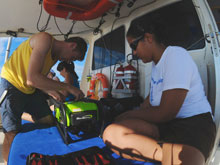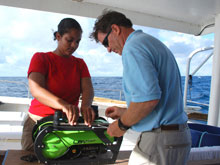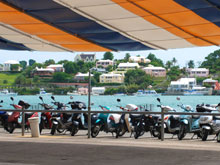Undergraduate student Alexis Hall helps Dr. Rikk Kvitek attach a conductivity, temperature, and depth (CTD) sensor to the remotely operated vehicle (ROV). The CTD data will help the team gather information about the water column near the potential cave sites. Click image for larger view and image credit.
An Undergraduate on the Team
September 27, 2009
Alexis Hall
California State University – Monterey Bay
As an undergraduate student at California State University – Monterey Bay (CSUMB), I am thrilled to have this opportunity to participate in the Bermuda caves expedition. Opportunities like this are typically reserved for graduate students, so when I was selected to go it was a big deal for me. I was able to come thanks to the Ronald E. McNair Program, which prepares undergraduate students for graduate work. My senior thesis project involved remotely operated vehicle (ROV) work, and the McNair program was able to connect me with Dr. Rikk Kvitek’s lab since they do a lot of small ROV work at CSUMB.
As part of the expedition team, I help with ROV deployment and recovery. My main job is to watch the tether — a bundle of electric and fiber optic cables that relays information between the ship and the ROV. I also keep log sheets during the expedition. The log sheets track the operations we complete during this expedition. We track the time the ROV was deployed, where we deployed, the time at depth, and also where the data collected from the ROV has been saved. This information will be invaluable later as we process data and go through the video taken by the ROV.
The first day marked the beginning of our 15-hour-long daily schedule. While this is long work day, it is important to collect as much data as we can. Time is the most valuable aspect of this project. Today, though, was more of a testing day. We had to make sure that all the ROV equipment worked and was able to record video. Even though the morning was rainy, work still had to be done. This day established what would become our typical workday.

Todd Hallenbeck and Alexis Hall troubleshoot and fix a minor problem with the ROVís thrusters. Click image for larger view and image credit.
The next two days were long workdays again, but we collected valuable data. There were species of interests, such as the lionfish and unknown coral species, that came up during the video transect. We explored areas that had many possible caves. Plus, our efficiency as an ROV team only got better. There were moments when quick troubleshooting was necessary if we were to continue collecting data. These experiences only made the ROV team stronger and able to work together even better.
With a few weather days canceling our boat outings, the research team took some time to organize the data. Another important aspect of the trip is that when the research team leaves, the project is over. This is an important factor that I had not realized until I got to Bermuda. Our end product needs to be in a useable format not only the principal investigator's use, but also for other research scientists interested in the Bermuda’s cave ecology. So we all compiled the data into a digital map form, analyzed the video and labeled key interest points, and tried to make our log sheets much more efficient.
With one car per household allowed in Bermuda, mopeds are a common form of transportation on the island. Click image for larger view and image credit.
We did get to explore the island during these weather days. One day we were able to explore the town and see what Bermuda is like. Despite being a lovely tourist town, there is a definite feel of island living here. Locals seem to know each other like friends; and the modes of transportation are mopeds, small cars, ferries, or buses. People are friendly to others. Also, a car horn is a common use of communication. Island living is unique living.
The last few days of our Bermuda trip have been long 15-hour days again. We have been working hard to collect any last bits of data that we can. While we could collect data for months, we had only a few days. So these days were very important research days. There is definitely the feeling of pressure on to finish our data collection and organize what data we have been able to collect. I have never felt this pressure before, because I have always had the luxury of going out to do some research anytime. So, I was a little anxious to get the best data that we could these last few days. It worked out well, for sure. We got as much data as we could, and we were able to have a finished product. The expedition was considered a success.
Working as part of this expedition has been an amazing opportunity. I have seen animals in the wild, explored previously unseen caves, and been able to work with a team of scientists to conduct a NOAA-funded research project. I truly feel like a marine scientist working on this project. There’s only a handful of scientists doing this research, and now I am one of them.















